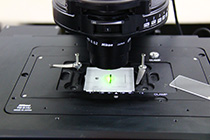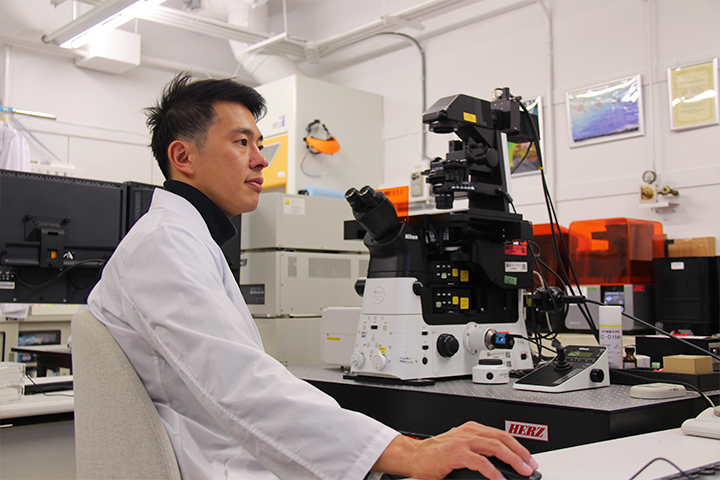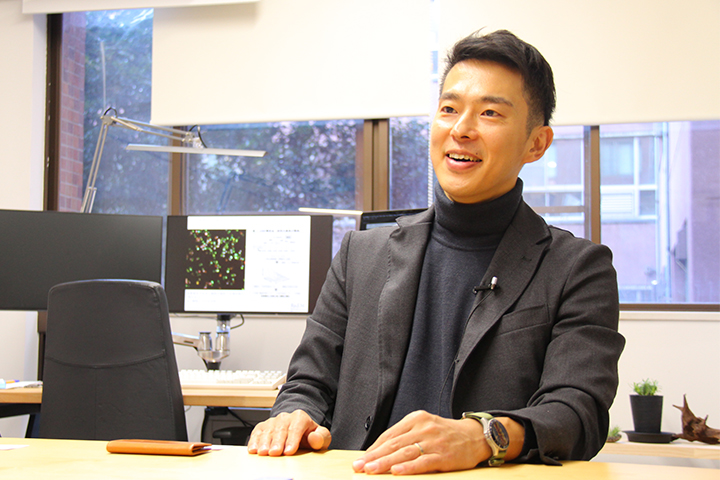TSUKUBA FUTURE
#119 Identifying the Light Emitted by Each Cell
Assistant Professor YAWATA Yutaka, Faculty of Life and Environmental Sciences

Nearly all cells are intrinsically luminescent (fluorescent). Cells contain various organelles and metabolites, which emit different light depending on their composition and state. Prof. YAWATA is developing technology that can distinguish the properties of individual cells from the collective light emitted by those cells, and is trying to elucidate the ecology and capabilities of microorganisms, which, despite being single cells, are indispensable for humans and the global environment.

Microorganisms were the first form of life to appear on Earth. Today, roughly 3.8 billion years after their appearance, they have evaded extinction and survived through many devastating changes in the global environment. Although invisible, countless types of microorganisms are everywhere, and they play an important role in maintaining the global environment. Since ancient times, when we didn't yet even know of their existence, we humans have been interacting with microorganisms in many ways, from fermenting our food to suffering from infectious diseases. However, there is still much we do not know regarding where and how microorganisms work, or what abilities they have. Prof. YAWATA's research involves observing microorganisms quantitatively on a cell-by-cell basis to clarify their properties.
Prof. YAWATA is focusing on "autofluorescence" as an index to understand the properties of microorganisms on a cell-by-cell basis. Autofluorescence is a property that is present in the cells of any living organism, including humans. When these cells are excited by light, autofluorescence allows their internal structure and characteristics to be reflected. In recent years, it has attracted attention as a technique that allows living cells to be diagnosed without them being damaged. Even among a single type of microorganism, different light is emitted by each individual cell depending on its state, but since microorganisms exist in groups of many individual cells (a biofilm), until now autofluorescence measurements could only be detected as mean values for a population. Prof. YAWATA combined ultra-sensitive confocal microscope technology and image processing technology to analyze the autofluorescence of each cell within a population. The purpose of this analysis was to find out which cells have autofluorescence, their positions within the population, and to develop these findings into a database. In addition, he implemented a machine learning model based on artificial intelligence (AI) to enable prediction of the properties of each cell. This makes it possible to screen for specific properties within a population, in which many types of microorganisms coexist, and to predict their properties and state without mass culturing. In microbial applications, it is necessary to collect only those cells that have the desired capabilities for humans, and this system also meets that need.

Microorganisms are surprisingly delicate. To analyze them properly, it is first of all important to observe them well and become familiar with them.
Prof. YAWATA has been studying microorganisms since he was an undergraduate. His research activities began in the field of agriculture, which has a history of developing practical learning from a combination of biology and engineering. For this reason, the idea of incorporating robotics (including AI) into biological research came naturally to him. Tools such as image analysis and big data are indispensable for highly accurate observation and understanding of microorganisms that live in environments and on scales completely different from those of humans. Nowadays, it's easier to use such technologies without having advanced expertise, and collaboration with experts means there is less hesitation to enter different fields.
Microorganisms flexibly change their genetic properties in response to the environment. Even while a single cell maintains its shape, its contents are continuously evolving. It doesn't need humans or other organisms, but it responds sensitively to various environmental factors. Such sensing capabilities are extremely wide-ranging. Depending on the type of microorganism, they can sense light or specific compounds, move with magnetic force, and even produce substances that are useful to humans. The microorganisms might simply be adapting to their surrounding environment, but given that slight changes in their behavior can affect the circulation of matter on Earth and cause fluctuations in the planet's environment, microorganisms can be said to be the most important organisms.
A large-scale program called the "NOMURA Microbial Community Control Project" for researching microorganisms from various perspectives is underway at the University of Tsukuba, and Prof. YAWATA is a member of the project. The ecology of microorganisms has been elucidated little by little in the course of this project, but the more he learns, the more he wishes to know. At such times, designing an analyzer with one's own ideas paves the way for unique research. Prof. YAWATA's laboratory is equipped with 3D printers and laser processing machines, in addition to equipment for culturing and observing microorganisms, and artful design is also an important element of his research. At some point, Prof. YAWATA wants to leave the laboratory and use his own analytical methods to study the behavior and properties of microorganisms around the world. With that thought in mind, he continues his present observations of microorganisms.

In fact, intestinal bacteria and pathogens are extremely familiar microorganisms, but not many people are aware of this. Prof. Yawata says he wants people to know more about how interesting microorganisms can be.
Article by Science Communicator at the Office of Public Relations



